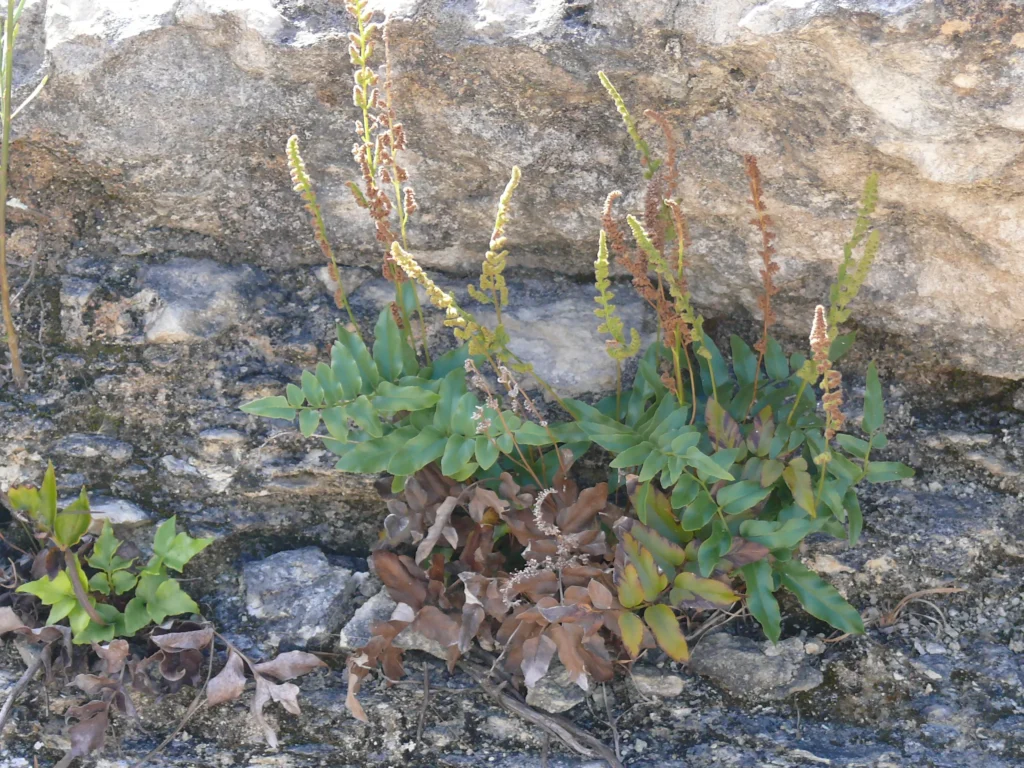Author: Bill Ward
If asked to name prominent native plants of the Texas Hill Country, would your list include a fern? Probably that would be the last plant named by most people. Ferns are an East Texas thing, aren’t they?
Actually, ferns grow in every part of Texas, including the dry parts. There are about 75 species of native ferns in the Trans-Pecos, of all places! For me, one of the most characteristic plants of Hill Country creeks and limestone canyons is the southern maidenhair fern (Adiantum capillus-veneris). This is our common fern with the pendant fronds of multiple-branched blades and small fan-shaped leaflets.

In this area, even the most ephemeral seeps and springs seem to encourage maidenhair to take root. Where seeps and springs are persistent, the crowded fronds of maidenhair make thick, lush blankets and drapes along stream banks and on wet limestone cliffs.
Another species of maidenhair is found just south of Medina Lake Dam, and no where else in the U.S. This is the hairy maidenhair (A. tricholepis), which is similar to southern maidenhair except the leaflets are slightly smaller and not lobed at the apex.
Southern maidenhair is easily transplanted and cultivated. It makes a good-looking plant on pond banks and can even grow in shady beds that are not too well-drained. During the hottest and driest months, the fronds may shrivel and turn brown, but usually the leaves will reappear in damper weather. It is fairly cold-tolerant in this area. The maidenhair fern around our little bird-bath pond has remained green all this winter.
Another common fern in the Hill Country is shield fern or river fern (Thelypteris ovate var. lindheimeri), which is endemic to the Edwards Plateau and a little farther west and into Mexico. This is the common large fern with long ovate fronds that is found along many streams in the Hill Country. It commonly grows with southern maidenhair, both along streams and on limestone canyon walls.
Thelypteris is commonly available in nurseries. Also, because it has shallow roots, it is easily transplanted from the wild into a garden. With just a little watering it is fairly drought-tolerant in shady areas. In this area, river fern dies back during the winter, but sends up fiddle heads as soon as warm weather returns.
One of my favorite native ferns is Mexican flowering fern (Anemia mexicana). This fern grows out of limestone ravines, cliffs, and hillsides, mostly in areas of seeps, but also in some fairly xeric places.

Unlike “typical” ferns, the Anemia frond has a blade with two types of leaflets, fertile and sterile. The 4 to 7 leathery sterile leaflets are lance-head-shaped, and the two fertile leaflets are spike-like with clusters of spores at the top. The non-sequitur name “flowering fern” comes from the spore spikes being mistaken for bloom stalks.
According to “Ferns and Fern Allies of the Trans-Pecos and Adjacent Area” by Sharon Yarborough and Michael Powell, Anemia mexicana is becoming popular as a landscaping ground cover in suitable locales. It is easy enough to transplant from the wild, but in my yard it grows very slowly. I haven’t yet found the “suitable locale.”
Several other ferns grow on the limestones in the Hill Country, some adapted to surprisingly dry areas. The east- and north-facing hillsides probably are the most likely places to finds ferns. In some places, just the shade of a boulder or rock ledge can provide habitat for a fern to thrive.
The acidic soils on Enchanted Rock, the granite knob north of Fredricksburg, support at least a dozen species of ferns. The Fredericksburg and Boerne Chapters of the Native Plant Society of Texas will sponsor a field trip to see the ferns of Enchanted Rock on May 11, 2009. Some of these species can’t be seen in any other parts of the Hill Country.


